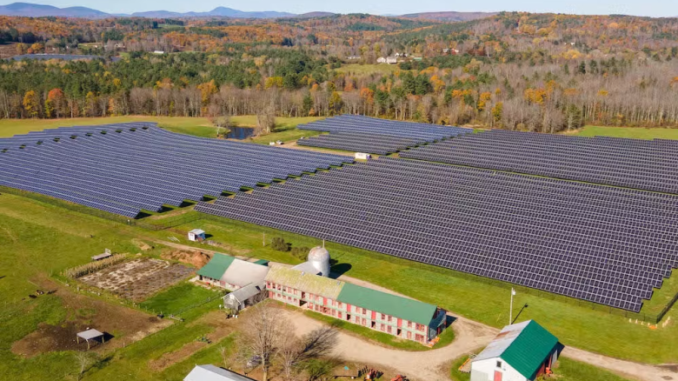
Solar developers will pay a premium to build projects on prime farmland under new rules in the works in Maine.
The state Department of Agriculture, Conservation and Forestry is drafting the rules based on a 2023 law that authorized it to collect extra fees from developers whose projects impact at least 5 acres of “high-value agricultural soils,” which regulators will define in rulemaking underway this summer.
The program could involve a range of new fees for different kinds of farmland and project impacts, with money being set aside for “farmland conservation and solar mitigation projects.” Proponents hope the rules will push renewable energy development toward areas with less conservation value.
“We would much rather see balanced solar siting than full-out moratoriums on solar energy development,” said Shelley Megquier, the policy and research director for Maine Farmland Trust, which supported the legislation authorizing the new rules.
Critics, though, say the rules unfairly single out solar based only on anecdotal evidence of the industry’s impact on farmland. A recent report by the American Farmland Trust projected that low-density housing and other types of urban sprawl threaten to swallow more than 53,000 acres, or 5% of all Maine farmland, by 2040.
The law also authorized the development of a similar scheme for wind and transmission projects that affect certain kinds of fish and wildlife habitat.
Some advocates say the new fees single out renewables without clear evidence that a use like solar puts prime farmland more at risk than any other kind of development.
“The narrative around this has really been: how can we protect high-value farmland from solar development?” said Lindsay Bourgoine, the policy director for ReVision Energy, a major New England solar developer. “ReVision has a really big concern about the lack of data around that narrative.”
Maine’s climate plan includes a goal of moving to 100% renewable electricity by 2040, and also aims to put 30% of the state’s land into conservation easements, including for farming, by 2030.
The state has already built close to a gigawatt of solar, most of it in smaller-scale projects. The five-acre minimum covered by the new compensation fees can support about a megawatt of solar.
Bourgoine’s company estimates that even if all of Maine’s existing solar projects under 5 megawatts had gone on prime agricultural lands, it would cover less than half a percent of all such land across the state. A recent report from the Center for Rural Affairs estimated a similar proportion for solar in Midwest states.
Groups that supported Maine’s new fee rules agreed that they hope legislators and state policymakers will turn their focus in the near future to both gathering more land-use data, and to considering expanding mitigation tools to uses that may be more common, such as housing, commercial development or roads.
“If we’re talking about environmental impacts, we’re requiring mitigation of the one type of development that is benefiting the environment,” said conservation biologist and GIS manager Sarah Haggerty of Maine Audubon, which supported the bill to create the clean energy fee programs.
Absent better data, Megquier said farmers and farm conservation groups like hers can only go on what they observe — which is “farmland being converted for solar production in pretty large amounts,” she said.
“Some of that (is) what we would categorize as really high-value farmland, where unfortunately it’s being lost to agricultural production,” she said. “There may be farmers that would be interested in accessing that land to grow food for our communities.”
Andy Smith and his partner run The Milkhouse dairy farm in Monmouth, Maine. They have their own small solar array and sit close to a power substation, and so have fielded extensive interest from solar developers who want to rent and build on some of their land. Some have offered more than $1,000 an acre for a 30-year lease, he said.
Smith said he’s strongly supportive of an energy transition and sees frequent effects of increasing weather extremes on his farm. But he said solar is tough competition for farmers who lease or buy space from other landowners, often to grow hay to feed dairy cows like Smith’s.
“If young people are trying to buy farmland, and they’re competing with solar developers, they’re not going to be able to buy farmland,” he said.
For farmers that affirmatively want solar on their land, Megquier’s group hopes the new fee structure will incentivize projects to go on “marginal” land that’s less productive, unforested or disconnected from large active growing areas.
“We hope that … this rulemaking takes those sorts of complexities into account,” she said. “We would want to see permitting for a solar development that supports current agricultural operation as sort of fast-tracked or, in some way, expedited.”
ReVision supports a similar outcome.
“We would just say that a landowner should have the default ability to be able to site solar on their property if the purpose of it is for revenue diversification to keep the farm in operation,” Bourgoine said.
Evelyn Norton’s family built this solar array on marginal soil on their Maine dairy farm; it’s now their largest source of income. (Credit: ReVision Energy) Credit: ReVision Energy
Evelyn Norton is one such landowner. Her father raised dairy cows and harvested hay to feed them on her family’s farm in Livermore Falls, Maine. As that business declined and her dad got older, Norton said she realized, realistically, that she and her sister “were not going to be out on the tractors haying… and so we realized we needed to figure out what else we could do to bring income into the farm.”
Numerous solar developers had contacted the family about putting an array on their land. Many were eyeing a particular flat, treeless area, close to grid infrastructure, with sandy soil. It had been the least productive plot for hay on the farm, Norton said.
“Someone referred to it as a Walt Disney solar farm property,” Norton said. “It was just like it was designed to be a solar array.”
Her family worked with ReVision to build a community solar array on that 20 acres, covering about 15% of the farm’s total area. The grass beneath the panels is grazed by sheep, and the array provides power to five school districts — a nod to Evelyn’s mother, who was a long-time teacher.
Annual lease payments now provide the farm’s largest source of revenue, supplemented by various other agricultural uses, such as tree-growing and a farmer who rents space for his cattle.
“We’re still wanting to stay as a one-unit farm and not have to sell off piece by piece. This allows us to do that,” Norton said. “It gives us the security to know that 135 acres is protected because of the 20 acres.”
Norton worries that the new fee structure, if not designed with the right exceptions, could prevent some farmers from using solar as she did to keep her farm viable.
Some advocates said they hope the rules will primarily help balance solar development costs so that farmland isn’t automatically the cheapest option.
Smith, the dairy farmer in Monmouth, said he hopes at least the new fees will encourage development on “lower-quality soils.” But it’s easier said than done — these soils may be less well drained, for example, and contain areas classified as wetlands, leading to more regulatory complications.
“It just often feels like, you know, a (good) solar site is going to be on well drained soil with southern exposure, which is also the best farmland there is,” he said.
“We sincerely hope that this effort will not have a chilling effect… and, in some cases… could assist solar companies in terms of the predictability,” Megquier said. “The current structure is really not a structure. It’s very … project-to-project. And that is not to the benefit of advancing our conservation goals, nor is it to the benefit of advancing our renewable energy goals.”
Under the new rules, regulators will have to define “dual-use agricultural and solar production,” such as agrivoltaics projects where crops and solar are co-located. Megquier hopes the new fees will incentivize this approach.
For Smith, dual-use methods are the best hope for easing rural and neighbor backlash to solar energy, which he worries will slow its growth as a tool for fighting climate change.
“It would really suck if the whole solar industry got like a black eye because of developing these open spaces,” he said.
Haggerty, with Maine Audubon, said increasing costs for building on farmland could make more costly solar sites — including brownfields and developed spaces — more appealing for builders by comparison.
“It may very well be that this legislation balances out some of those costs, you know — if you’re gonna have to mitigate… ag land or wildlife habitat, maybe it makes that brownfield more affordable, and it’s not as much cheaper to go elsewhere,” she said. “That’s one of the things that we hope to see.”
The state is currently gathering stakeholder input on a draft farmland rule expected out this summer. The Maine legislature will have to approve the eventual fee structures, which will apply to solar arrays that begin construction after Sept. 1, 2024.






